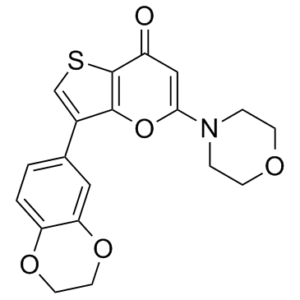SF2523
This product is for research use only, not for human use. We do not sell to patients.

For small sizes, please check our retail website as below: www.invivochem.com
| Size | Price | Stock |
|---|---|---|
| 250mg | $1080 | Check With Us |
| 500mg | $1550 | Check With Us |
| 1g | $2325 | Check With Us |
Cat #: V2969 CAS #: 1174428-47-7 Purity ≥ 98%
Description: SF2523 (SF-2523; SF 2523) is a novel, selective and potent dual inhibitor of PI3K-BRD4 with potential anticancer activities.
Top Publications Citing Invivochem Products
Publications Citing InvivoChem Products
Product Promise

- Physicochemical and Storage Information
- Protocol
- Related Biological Data
- Stock Solution Preparation
- Quality Control Documentation
| Molecular Weight (MW) | 371.41 |
|---|---|
| Molecular Formula | C19H17NO5S |
| CAS No. | 1174428-47-7 |
| Storage | -20℃ for 3 years in powder formr |
| -80℃ for 2 years in solvent | |
| Solubility In Vitro | DMSO: 29 mg/mL (78.08 mM)r |
| Water: <1 mg/mLr | |
| Ethanol: 7 mg/mL (18.84 mM) | |
| SMILES Code | O=C1C=C(N2CCOCC2)OC3=C1SC=C3C4=CC=C(OCCO5)C5=C |
| Synonyms | SF2523; SF-2523; SF 2523 |
| Protocol | In Vitro | SF2523 treatment decreases protein levels of MYCN and Cyclin D1, the MYCN target, and inhibits AKT activation by blocking phosphorylation of AKT at Ser473. SF2523 treatment leads to the displacement of BRD4 from both MYCN promoter sites. SF2523 interacts robustly with the full-length BRD4 (Kd=140 nM) and exhibits comparable affinity to the BRD4 first BD (BD1) (Kd=150 nM), however it binds more weakly to the second BD (BD2) of BRD4 (Kd=710 nM). Comparison of binding affinities of SF2523 for BDs of other proteins reveal that it binds equally well to BDs of BRD4, BRD2, and BRD3; shows moderate binding to BDs of CECR2 and BRDT; but associates much weaker with other BDs. |
|---|---|---|
| In Vivo | SF2523 treatment results in a significant reduction of tumor volume compared with control. Importantly, SF2523 shows no gross toxicity to the treated mice, as there is no notable change in body weight. Tumors from SF2523-treated mice have markedly reduced MYCN, pAKT, and Cyclin D1 levels compared with levels of these proteins in vehicle-treated mice tumors. |
These protocols are for reference only. InvivoChem does not
independently validate these methods.
| Solvent volume to be added | Mass (the weight of a compound) | |||
|---|---|---|---|---|
| Mother liquor concentration | 1mg | 5mg | 10mg | 20mg |
| 1mM | 2.6924 mL | 13.4622 mL | 26.9244 mL | 53.8488 mL |
| 5mM | 0.5385 mL | 2.6924 mL | 5.3849 mL | 10.7698 mL |
| 10mM | 0.2692 mL | 1.3462 mL | 2.6924 mL | 5.3849 mL |
| 20mM | 0.1346 mL | 0.6731 mL | 1.3462 mL | 2.6924 mL |
The molarity calculator equation
Mass(g) = Concentration(mol/L) × Volume(L) × Molecular Weight(g/mol)
Mass
=
Concentration
×
Volume
×
Molecular Weight*
The dilution calculator equation
Concentration(start)
×
Volume(start)
=
Concentration(final)
×
Volume(final)
This equation is commonly abbreviated as: C1 V1 = C2 V2
Concentration(start)
C1
×
Volume(start)
V1
=
Concentration(final)
C2
×
Volume(final)
V2
Step One: Enter information below
Dosage mg/kg
Average weight of animals g
Dosing volume per animal µL
Number of animals
Step Two: Enter the in vivo formulation
%DMSO
+
%
+
%Tween 80
+
%ddH2O
Calculation Results:
Working concentration:
mg/ml;
Method for preparing DMSO master liquid:
mg
drug pre-dissolved in
µL
DMSO(Master liquid concentration
mg/mL)
,Please contact us first if the concentration exceeds the DMSO solubility of the batch of drug.
Method for preparing in vivo formulation:
Take
µL
DMSO master liquid, next add
µL
PEG300, mix and clarify, next add
µL
Tween 80,mix and clarify, next add
µL
ddH2O,mix and clarify.
Note:
- (1) Please be sure that the solution is clear before the addition of next solvent. Dissolution methods like vortex, ultrasound or warming and heat may be used to aid dissolving.
- (2) Be sure to add the solvent(s) in order.




































